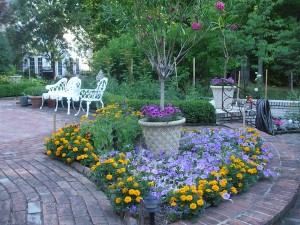
Croquet mallets serve as hose guides in an Irvington garden border planted with perennials. © Jo Ellen Meyers Sharp
We hear landscape and garden terms bandied about all the time, but do we know what they mean?
I must confess that I only recently learned the difference between a garden bed and garden border. I thought they were interchangeable, but they really aren’t. And what about whether a plant is an annual or perennial?
Here’s a primer:
Annual — goes from seed to flower to seed in one season. Usually killed by cold temperatures. Many tropical or tender plants, such as lantana and impatiens, are called annuals, even though they may be perennials in their natural range.
Biennial — a perennial that has a two-year growth cycle. In year one, it goes from seed to a low-growing cluster of leaves called a rosette. The plant blooms in year two, drops seeds, which form rosettes for next year’s flowers. Hollyhock (Alcea), foxglove (Digitalis) and parsley (Petroselinum) are among the biennials.
Deciduous — trees and shrubs that drop their leaves in fall. Most woody plants fall into this category, including maple, oak, roses, viburnum and hydrangea.
Evergreen — Retains leaves through winter. Needle evergreens include conifers, such as pines, spruces, junipers and yews. Broadleaf evergreens include rhododendrons and some hollies. Some perennials also can be considered evergreen because they retain their foliage in winter. Hellebore (Helleborus), lily turf (Liriope) and coral bells (Heuchera) are examples of evergreen perennials.

Annuals yellow marigolds and blue petunias fill a garden bed surrounded by brick. © Jo Ellen Meyers Sharp
Garden bed — usually can be seen from all sides. Can be any shape or size and have any kind of plants.
Garden border — usually backed by a structure, such as a house or fence.
Herbaceous — usually dies back to the ground in winter. Most perennials fall into this category.
Perennial — comes back every year when selected for the proper heat and cold hardiness and planted in the proper place.